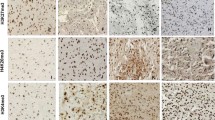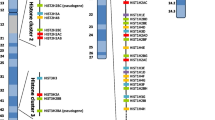Abstract
Background
Histones are proteins closely associated with the DNA molecules and serve as a structural scaffold for the organization of chromatin. They play an important role in the regulation of gene expression by changing the level of DNA compaction.
The special subtype of the linker histone family—H1 zero (H1.0) is generally expressed in non-dividing, terminally differentiated cells.
The aim of our study is to investigate the correlation between the quantities of histone H1.0 in human gliomas, the histopathological grade and the overall survival.
Material and method
Twenty-nine (N = 29) patients with intraaxial lesions underwent a microsurgical tumor resection. Tumor samples were snap-frozen in liquid nitrogen immediately after resection.
Following a specific protocol, linker histones were extracted from the tumor specimens and the quantities of histone H1.0 were assessed. All patients were followed up prospectively.
Results
Of the 29 patients in our study (M:F = 17:12), five had a grade II astrocytoma, seven had a grade III, and 17 had a grade IV, according to the World Health Organization (WHO) classification.
At the end of the study, three patients were still alive.
The mean quantities of H1.0 were: 23.3 for grade II tumors, 13.9 for grade III and 11.3 for grade IV tumors.
The statistical analysis demonstrated that the histological grade, age and Karnofsky performance status (KPS) remain among the most reliable predictive factors for the survival of patients with gliomas.
Grade III–IV gliomas had significantly less histone H1.0 than grade II gliomas. Conformably, in a multivariate Cox regression analysis, H1.0 made a small but significant contribution (p < 0.05) to survival rates.
Conclusion
Our study confirmed that histone H1.0 is a potential biological marker with prognostic value for the survival of patients with gliomas. The quantities of histone H1.0 are correlated to the histopathological grade of the tumor. The more aggressive and malignant gliomas tend to have lower quantities of histone H1.0.

Similar content being viewed by others
References
Portela A, Esteller M (2010) Epigenetic modifications and human disease. Nat Biotechnol 10:1057–68
Van Holde KE (1989) Chromatin. Springer, New York
Luger K (2006) Dynamic nucleosomes. Chromos Res 14:5–16
Fischle W, Wang Y, Allis D (2003) Histone and chromatin cross-talk. Curr Opinion Cell Biol 15:172–183
Harvey AC, Downs JA (2004) What functions do linker histones provide? Mol Microbiol 53(3):771–775
McBryant S, Lu X, Hansen J (2010) Multifunctionality of the linker histones: an emerging role for protein-protein interactions. Cell Res 20:519–528
Sancho M, Diani E, Beato M, Jordan A (2008) Depletion of human histone H1 variants uncovers specific roles in gene expression and cell growth. PlosGenet 4:e1000227
Warneboldt J, Haller F, Horstmann O, Danner B, Füzesi L, Doenecke D, Happel N (2008) Histone H1x is highly expressed in human neuroendocrine cells and tumours. BMC Cancer 8:388
Zlatanova J, Doenecke D (1994) Histone H1 zero: A major player in cell differentiation? FASEB J 8:1260–1268
Marks D, Kanefsky T, Keller B, Marks A (1975) The presence of histone H1 degree in human tissues. Canc Res 35:886–889
Tsanev R, Hadjiolov D (1978) Chromosomal proteins in hepatocarcinogenesis. J Cancer Res Clin Oncol 91:237–247
Giancotti V, Bandiera A, Ciani L, Santoro D, Crane-Robinson C, Goodwin GH, Boiocchi M, Dolcetti R, Casetta B (1993) High-mobility-group (HMG) proteins and histone H1 subtypes expression in normal and tumor tissues of mouse. Eur J Biochem 213:825–832
Kostova N, Srebreva L, Milev A, Bogdanova O, Rundquist I, Lindner H, Markov D (2005) Immunohistochemical demonstration of histone H1(0) in human breast carcinoma. Histochem Cell Biol 124:435–443
Smith BJ, Johns EW (1980) Isolation and characterisation of subfractions of nuclear protein H1 degree. FEBS Lett 110(1):25–29
Kolev N, Georgieva M, Gabrovsky N, Uzunov K, Miloshev G (2006) Assessment of histone H10 levels in Glioblastoma multiforme. Compt Rendus de l'Acad Bulgare des Sci 59:89–98
Albig W, Runge D, Kratzmeier M, Doenecke D (1998) Heterologous expression of human H1histones in yeast. FEBS Lett 435:245–250, differentiation? The FASEB J 8:1260–1268
Miloshev G, Zlatanova J, Srebreva L, Tsanev R (1985) Presence of a H1о-type histone in an invertebrate—the bivalve mollusk Anodonta cygnea. Comp Biochem Physiol 82B:759–761
Lea M (1987) Relationship of H1(0) histone to differentiation and cancer. Cancer Biochem Biophys 3:199–209
Gunjan A, Alexander B, Sittman D, Brown DT (1999) Effects of H1 histone variant overexpression on chromatin structure. J Biol Chem 274:37950–37956
Girardot V, Rabilloud T, Yoshida Y, Beppu T, Lawrence J, Khochbin S (1994) Relationship between core histone acetylation and histone H10 gene activity. Eur J Biochem 224:885–892
Mannironi C, Rossi V, Biondi A, Ubezio P, Masea G, Barbui T, D’Incalci M (1987) Histone H1° is synthesized by human lymphocytic leukemia cells but not by normal lymphocytes. Blood 70:1203–1207
Acknowledgements
N.G. is supported by the Bulgarian Science Fund, Grant number ТК02-468/2009.
M.G. is supported by the Bulgarian Science Fund, Grant number DMU 02/8 and from the World Federation of Scientists, National Scholarship Programme.
G. M. is supported by the Bulgarian Science Fund, Grant number DID 02/35.
Conflicts of interest
None.
Author information
Authors and Affiliations
Corresponding author
Rights and permissions
About this article
Cite this article
Gabrovsky, N., Georgieva, M., Laleva, M. et al. Histone H1.0—a potential molecular marker with prognostic value for patients with malignant gliomas. Acta Neurochir 155, 1437–1442 (2013). https://doi.org/10.1007/s00701-013-1802-1
Received:
Accepted:
Published:
Issue Date:
DOI: https://doi.org/10.1007/s00701-013-1802-1




